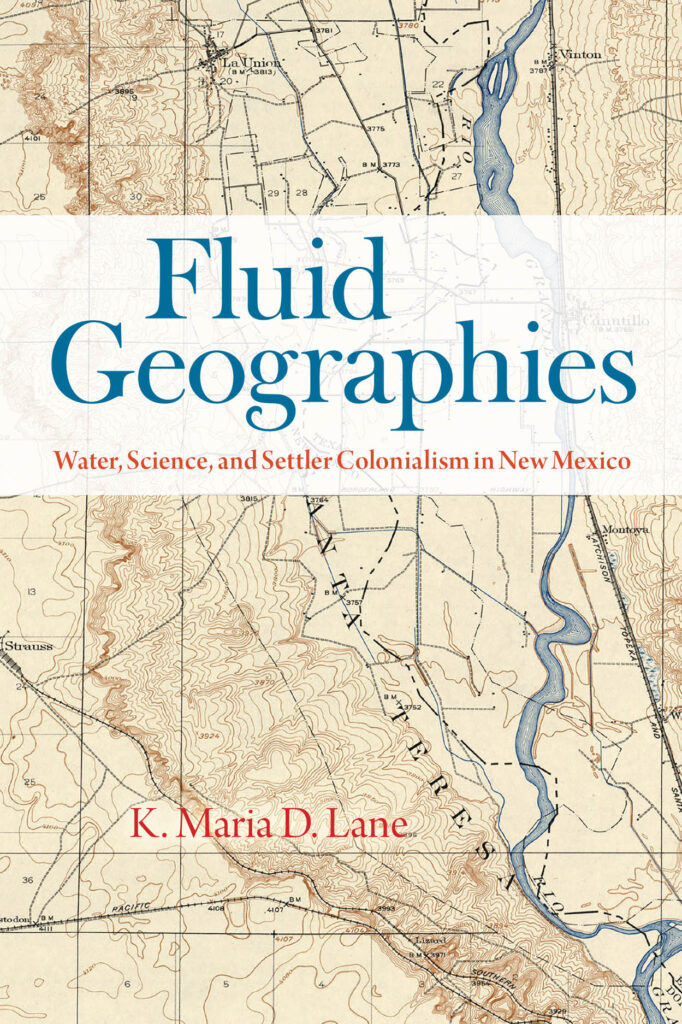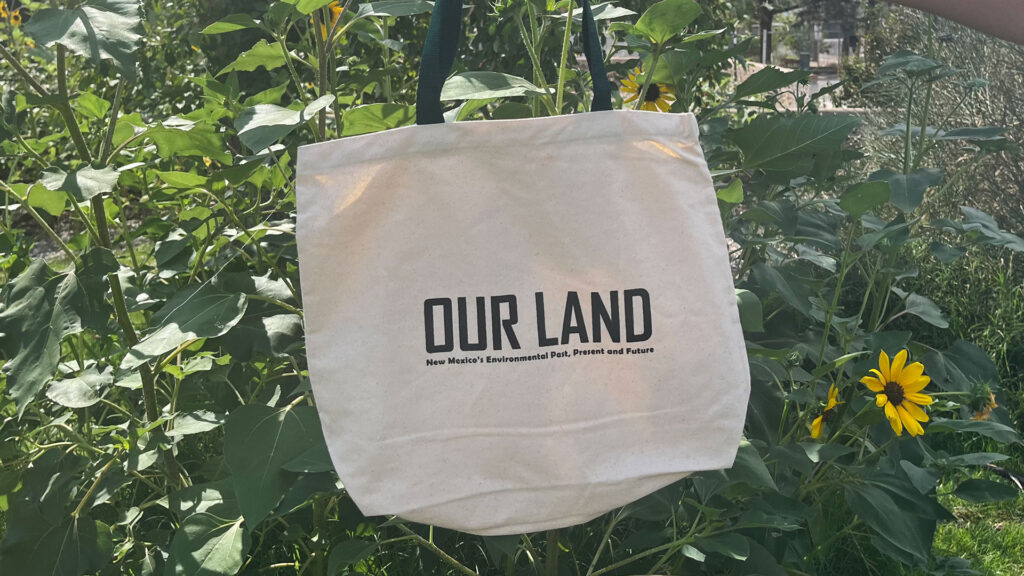Rio Chama sediment, atomic bomb survivors, and more

This week on New Mexico in Focus, the University of New Mexico’s Dr. K. Maria Lane joins me in the studio to talk about her latest book, Fluid Geographies: Water, Science, and Settler Colonialism in New Mexico. I am so excited about this book, which should make waves in New Mexico water management. Here’s a sneak peek of Fluid Geographies, from the Introduction:
“The Indigenous critical theorist Jodi Byrd argues that decolonization is possible only through a different kind of theoretical stance, one that is derived not from poststructural theory but from Indigenous theory. This book offers a precursor to that step, providing a detailed critique of the racialized disadvantage encoded in New Mexico’s water-management policies, institutions, and technologies. It explores the complex power dynamics that both constrained and emerged from modernist water-management structures during New Mexico’s territorial period. And it identifies a precise new way of talking about settler knowledge structures and their weak points. I offer Fluid Geographies in solidarity with other thinkers working to imagine new environmental futures that supersede the reclamation era and its colonial injustices.”
You can watch that conversation Friday night during New Mexico in Focus, or on the PBS App or the Our Land channel on YouTube.
It’s been a while since I attended (virtually or otherwise) a Middle Rio Grande Conservancy District meeting — and I learned a lot during yesterday’s regular board meeting.
Among the things I learned: There’s still a little San Juan-Chama water in storage, but after August, farmers should expect extended periods without any water deliveries. And: New Mexico’s cumulative debt under the Rio Grande Compact currently exceeds 121,000-acre feet.
The Bureau of Reclamation’s Area Manager, Jennifer Faler, also ran through various projects and issues related to her agency, including El Vado Dam, the federal assessment team’s work on water claims issues with the Middle Rio Grande pueblos, and the Lower San Acacia Reach Improvements Project. Faler also updated the board about the Rio Chama sediment plug.
As you all likely recall, a storm on June 20 sent water, mud, and debris rushing down Arroyo la Madera, causing the Rio Chama to become clogged with a dam of sediment that was 100 feet wide, four- to five-feet deep, and about a mile-and-a-half long. The storm wreaked havoc with the channel and nearby homes, and the plug also restricted Reclamation’s ability to deliver water downstream, including to irrigators in the Middle Rio Grande.
Using amphibious excavators (which you can see photos of at the Abiquiu News), crews have opened enough of a channel to move water downstream again. But work is ongoing, the sediment plug is still there, and local acequias are still affected.
“This will become more the norm, than an ‘emergency event,’” said Faler, “and we really want to get the word out that one rain event can do this.”
In other words, you don’t have to live downstream of a burn scar to be worried about flooding, especially as the climate continues to warm. And it’s a good time to rethink how we live next to, rely upon, care for, and “manage” our rivers.
If you’ve lived or worked at or near Cannon Air Force Base, you might be eligible for free confidential PFAS blood testing this fall. To find out more, attend an informational meeting hosted by the New Mexico Environment Department and Department of Health on August 27 at 6 p.m. at the Clovis Civic Center, 801 Schepps Boulevard, Clovis. You can also email drew.goretzka@env.nm.gov for additional information.
In the news:
• “State wants to address drinking water issues at 138 local systems” (Danielle Prokop, Source New Mexico)
• “Data shows Rio Grande water shortage is not just due to Mexico’s lack of water deliveries” (Berenice Garcia, The Texas Tribune)
• “Auction of King family property near Moriarty expected to generate millions” (Daniel Chacón, Santa Fe New Mexican)
• “New video shows world’s largest wildlife crossing starting to take form” (Rosanna Xi, Los Angeles Times)
• “As wildfire season becomes more threatening, experts are turning to AI” (Paige Gross, Source NM)
• “A melting Alaska glacier keeps inundating Juneau. Floods are getting worse.” (Joshua Partlow, The Washington Post)
• “Rez dogs are feeling the heat from climate change” (Taylor Dawn Stegner, Grist)
• “Warming Is Pushing Earth Closer and Closer to Dangerous Tipping Points” (Raymond Zhong and Mira Rojanasakul, The New York Times)
If you haven’t seen it already, check out “The Last Survivors of an Atomic Bomb Have a Story to Tell” (Kathleen Kingsbury, W.J. Hennigan and Spencer Cohen, with photographs by Kentaro Takahashi, The New York Times).
It’s a stunning piece of work, and it reminded me of the surreal experience I had almost 20 years ago, joining Shigeko Sasamori for lunch at Sadie’s as she met with a staffer working for then-Rep. Tom Udall. (Udall’s office was the only one that would meet with her during that visit.)
Sasamori was 13 when an American pilot dropped an atomic bomb on Hiroshima. It was the first day of school, and she and other students were out on the street. She had just one question back in 2007 for New Mexico’s elected officials: “Why is America still making nuclear weapons?”
Of course, now, we’re making even more.
Also check out Katherine Rundell’s excellent piece in The New Yorker, “Beware of Sharkless Waters.” I love, most of all, this part: “There is no such thing as shark-infested waters, in the same way that there is no such thing as a child-infested school. You cannot infest your own home.”
I became a Simone Weil fan after the Los Alamos Study Group’s Greg Mello quoted her on the show a few years ago. Naturally, I needed to read letters she wrote to her brother that The Paris Review published last week. Pretty sophisticated correspondence, considering that my main communication with my own (brilliant!) brother these days is texting him videos of my dog eating a tiny peanut butter cracker or refusing to eat a pickle. But alas, we live in different times…
And, I have a giveaway! We have a limited number of very special Our Land tote bags. I’ll send one off to our youngest Our Land Weekly subscriber. Drop me a note (you can even reply to this email) before Thursday to introduce yourself and tell me what you like reading about, and I’ll send you a tote bag.

Lastly, I won’t be haunting your inbox again until September 10 — but I have an assignment for you! GO OUTSIDE. Hike, swim, bike…daydream, nap, walk with a friend, pull out crabgrass and goat heads. But kill your social media accounts (maybe forever?), hug your loved ones, and take some deep breaths wherever you live or roam.
P.S. If a friend forwarded you this message, sign up here to receive the newsletter yourself. You can also read recent newsletters online. And if you miss us throughout the week, follow Our Land on Instagram.


